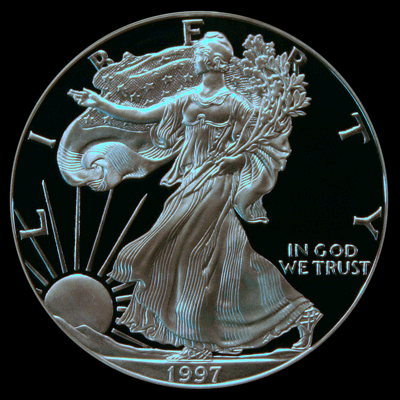Recently, rumors started that the US Mint would produce proof Eagles in 2010. As of September 8 (see our blog post), product release information about the proof American Eagles did not exist on the Mint’s release schedule. As of today (9/22), they list 2010 American Eagle Gold Proof Coins will be available on 10/7/2010. Silver proof eagles remain TBD (To Be Determined) in their schedule of products.
As for the gold proof eagles, people called the Mint and obtained specific information about the quantities. The quoted limits (subject to change) will be 39,000 for the four coin sets with individual coin option limits at 25,000 for the one ounce, 15,000 for the one-half ounce, 16,000 for the one-quarter ounce and 27,000 for the one-tenth ounce coins. Release of these limited quantities begins at noon (12:00 pm) Eastern time on October 7, 2010.
Remember, in 2009, the US Mint did not produce any proof silver or gold American Eagles, but they did provide over 28 million (almost 29M) uncirculated Silver Eagle coins.
So, what’s the difference between the Mint’s uncirculated and proof coins?
In 2005, the US Mint began making uncirculated coins with a satin finish using special dies. The smooth, satin finish readily distinguishes the uncirculated coins from circulated – in the case of pocket change. For collectible and investment coins, such as the commemoratives and the American Eagles, the satin finish differs greatly from the proof versions.
On their web site, the US Mint claims, “Today’s proofs are made as carefully as pieces of expensive jewelry.” Proof coins start as a highly polished blank, and on special coining presses, these blanks are struck at least twice with the special proof dies. The coin’s field appears mirror-like while the raised design has a frosted look.
You’re thinking, “OK, OK, I know all this already, what’s your point?”
Well, do you know what “proofed” is?
One of the cable shopping channels just started offering “2009 proofed silver eagles.” Their web site claims they have “taken a collection of original, non-proof US Mint struck 2009 Silver Eagles that had no mint mark, created new dies, and individually over-struck each coin to create the beautiful polished proof-like finish coveted by collectors.” As a footnote, they carefully add that the US Mint has “not approved, endorsed, sponsored or authorized” their efforts for the 2009 “proofed” silver eagle.
Furthermore, their online price for these “proofed” coins is just under $100 per coin. Ouch.
In reality, the purchasers of this “proofed” coin may enjoy a slightly improved finish over the uncirculated version of the 2009 Silver Eagle in the short term. But, long term, the coin will not retain better than melt value. Why? From a numismatic perspective, the coin has been defaced. Defaced coins do not retain value for their artistic finish.
The better choice for a collector or investor would be to purchase older, but true US Mint, proof versions of the American Silver Eagle.
For example, here’s a beautiful version of the 1997 Eagle’s obverse.
Isn’t she gorgeous?
Many of these older proof Eagles can be obtained for much less than the purchase price for the “proofed” coin. Whereas the “proofed” eagle’s long-term value is basically the melt value of silver, the true proof coins will retain their value as a proof coin. Yes, there could be some fluctuation within their market, but the value won’t immediately decrease to melt value.
Of course, if people really want a 2009 “proofed” Silver Eagle, the cable shopping channel will be happy to oblige. The purchasers just shouldn’t be surprised or disappointed when they go to sell the coin as a “proofed” coin and dealers only offer the current melt value.
Now, when playing coin word games, you’ll know the difference between uncirculated, proof and proofed!
Note: a link to the web site for the “proofed” coins was intentionally left out of today’s post. If you want to find the site, do a search using “2009 Silver Eagle Overstruck Proofed” in your favorite search engine.
